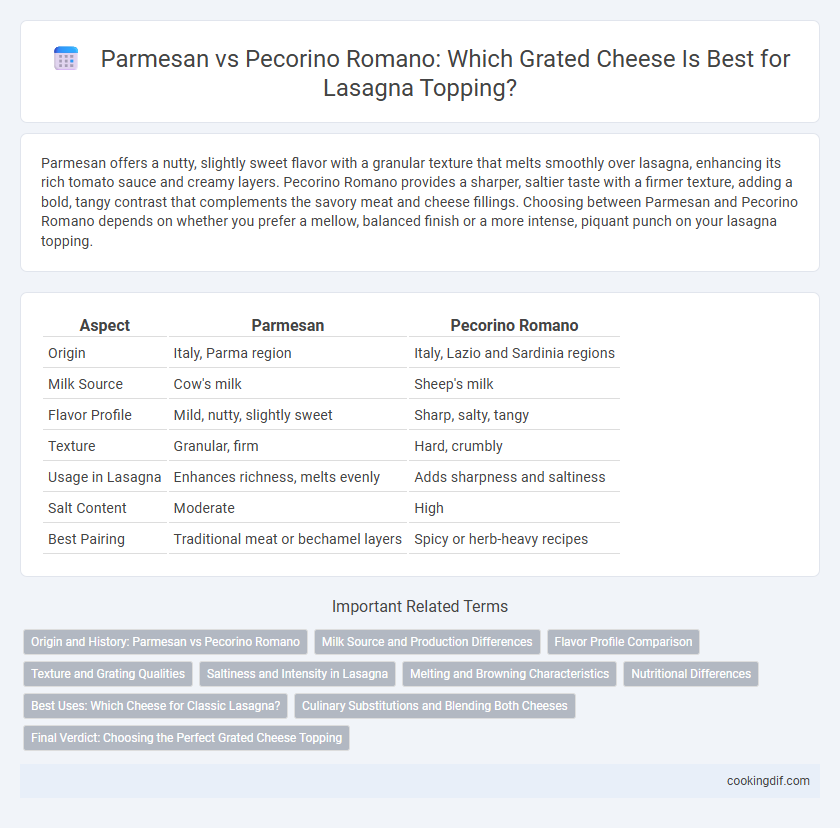Parmesan offers a nutty, slightly sweet flavor with a granular texture that melts smoothly over lasagna, enhancing its rich tomato sauce and creamy layers. Pecorino Romano provides a sharper, saltier taste with a firmer texture, adding a bold, tangy contrast that complements the savory meat and cheese fillings. Choosing between Parmesan and Pecorino Romano depends on whether you prefer a mellow, balanced finish or a more intense, piquant punch on your lasagna topping.
Table of Comparison
| Aspect | Parmesan | Pecorino Romano |
|---|---|---|
| Origin | Italy, Parma region | Italy, Lazio and Sardinia regions |
| Milk Source | Cow's milk | Sheep's milk |
| Flavor Profile | Mild, nutty, slightly sweet | Sharp, salty, tangy |
| Texture | Granular, firm | Hard, crumbly |
| Usage in Lasagna | Enhances richness, melts evenly | Adds sharpness and saltiness |
| Salt Content | Moderate | High |
| Best Pairing | Traditional meat or bechamel layers | Spicy or herb-heavy recipes |
Origin and History: Parmesan vs Pecorino Romano
Parmesan, or Parmigiano-Reggiano, originates from the Parma, Reggio Emilia, Modena, and Bologna regions of Italy, with a production history dating back to the Middle Ages, making it one of the oldest and most revered hard cheeses. Pecorino Romano hails from the Lazio region near Rome and Sardinia, dating to ancient Roman times when it was a staple in the Roman diet and remains a sharp, salty sheep's milk cheese known for its bold flavor. Both cheeses reflect their geographic and cultural origins, influencing their distinct taste profiles and traditional uses in Italian cuisine like lasagna toppings.
Milk Source and Production Differences
Parmesan cheese, made from cow's milk, undergoes a lengthy aging process of at least 12 months, resulting in a rich, nutty flavor ideal for lasagna topping. Pecorino Romano, crafted from sheep's milk, offers a sharper, saltier taste due to its quicker aging period of about 5 to 8 months. These distinct milk sources and production methods create unique textures and flavor profiles that significantly influence the final lasagna experience.
Flavor Profile Comparison
Parmesan offers a nutty, savory flavor with a slightly sweet and umami-rich profile, making it a classic choice for lasagna toppings. Pecorino Romano brings a sharper, saltier, and more pungent taste due to its sheep's milk base, adding a bold, tangy kick that contrasts with the creamy layers. Choosing between Parmesan and Pecorino Romano depends on whether a milder, balanced flavor or a more intense, robust seasoning is preferred for the dish.
Texture and Grating Qualities
Parmesan is known for its granular texture and easy grating qualities, creating a light, flaky topping that melts evenly on lasagna. Pecorino Romano has a harder, denser texture, producing finer, sharper grated cheese that adds a more intense salty flavor and a slightly crisp finish. The choice between Parmesan and Pecorino Romano impacts the lasagna's overall mouthfeel, with Parmesan offering a smoother melt and Pecorino providing a bold, textured bite.
Saltiness and Intensity in Lasagna
Parmesan cheese offers a balanced saltiness and a nutty, mellow intensity that enhances lasagna without overpowering other flavors. Pecorino Romano is significantly saltier and has a sharper, more pungent taste, making it ideal for those seeking a bold and intense cheese topping. Selecting between Parmesan and Pecorino Romano depends on whether a subtle or robust flavor profile is desired in the lasagna's final presentation.
Melting and Browning Characteristics
Parmesan cheese offers excellent browning properties and a rich, nutty flavor that enhances lasagna's top layer, melting smoothly without becoming oily. Pecorino Romano melts less uniformly due to its saltier and drier texture, resulting in a more textured and sharper-tasting topping with less browning. Selecting Parmesan improves the lasagna's golden crust and creamy consistency, while Pecorino Romano provides a distinctive tang and firmer finish to the cheese topping.
Nutritional Differences
Parmesan cheese contains less sodium and more calcium compared to Pecorino Romano, making it a heart-healthier option with stronger bone benefits. Pecorino Romano is higher in protein and fat, providing a richer, saltier flavor that enhances lasagna's savory profile. Selecting Parmesan over Pecorino Romano reduces overall sodium intake while still delivering essential nutrients, tailoring the dish to better meet dietary preferences.
Best Uses: Which Cheese for Classic Lasagna?
Parmesan is the best choice for classic lasagna topping due to its nutty, savory flavor that complements the rich tomato sauce and creamy bechamel. Pecorino Romano offers a sharper, saltier taste that works well in lasagna recipes with stronger, spicier fillings or sausage. For authentic Italian lasagna, Parmesan provides the perfect balance of melt and flavor without overpowering the dish.
Culinary Substitutions and Blending Both Cheeses
Parmesan and Pecorino Romano offer distinct flavors for lasagna toppings, with Parmesan providing a nutty, mellow taste, while Pecorino Romano adds a sharp, salty punch. When making culinary substitutions, blending both cheeses balances creaminess and intensity, enhancing the overall complexity of the dish. This combination optimizes texture and flavor, creating a richer, more nuanced grated cheese topping.
Final Verdict: Choosing the Perfect Grated Cheese Topping
Parmesan offers a nutty, mildly salty flavor that melts smoothly, making it ideal for a balanced lasagna topping. Pecorino Romano delivers a sharper, saltier taste with a more assertive bite, adding boldness to the dish's flavor profile. For the perfect grated cheese topping, Parmesan is preferred for its creamy consistency and subtle enhancement, while Pecorino Romano suits those seeking a more pronounced, tangy finish.
Parmesan vs Pecorino Romano for grated cheese topping Infographic

 cookingdif.com
cookingdif.com